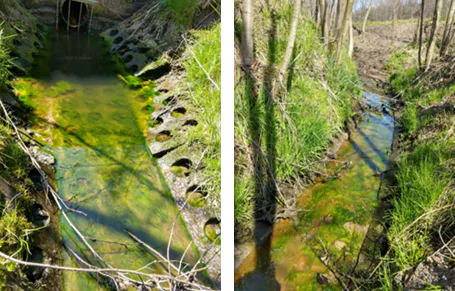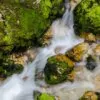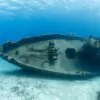Science
Macroalgae – an indicator of the quality of suburban watercourses acting as sewage receivers
In Poland, pollution of surface water by nutrients is still a very significant problem that significantly affects aquatic ecosystems and requires continuous assessment. The main purpose of environmental monitoring is to provide knowledge about the ecological and chemical status of rivers. This is necessary for the proper management of river basins, including their protection from eutrophication and anthropogenic pollution.
However, covering all surface waters in the assessment is impossible. The focus was therefore on small watercourses, whose cleanliness is affected by, among other things. Point sources of pollution emissions, i.e. discharges of treated municipal wastewater. This fact is particularly important in the face of declining water resources, and thus the need for urban and rural residents to use water sparingly.As a result, the volume of domestic wastewater generated per day is decreasing, but at the same time the loads of pollutants in them are increasing, among other things. Nitrogen and phosphorus compounds.
One way to assess the level of pollution of surface water by nutrients is to use the indicator role of organisms. Macroalgae are useful here. These organisms are very sensitive indicators of trophy. In the case of small watercourses, the impact of wastewater treatment plant discharges on water quality is manifested by an increase in the number of macroalgae attached to the solid substrate (Fig. 1a) or floating freely below the water surface (Fig. 1b). Good lighting conditions and high water temperatures further promote the growth of algae, which can overgrow the bottom of the watercourse or occupy space on the water surface.

Macroalgae may indicate water pollution by nutrients
In freshwater ecosystems, characterized by elevated nutrient concentrations, an intense growth of macroscopic filamentous green algae is observed at the peak of the growing season. They form single- or multi-species mats of algae from the genera Cladophora sp.(branch), Rhizoclonium sp.(rhizoclonium)and Oedogonium sp. (entangled). Macroalgae have an ecological and economic impact on the environment. Extensive mats of filamentous green algae (Fig. 1) die off, increasing the siltation of the watercourse and thus reducing the oxygen content of the water.
Macroalgae are optimal bioindicators because they respond to changes in the physicochemical composition of water over a much longer time frame than other aquatic organisms. Species of the genus Cladophora sp. (Fig. 2) develop in highly morphologically transformed areas and in zeutrophic waters with alkaline pH. The growth of branchwort is mainly related to phosphate pollution of the watercourse. Some species of branchwort form spherical mats (balls up to ten centimeters in diameter), but most are found as branched mats attached to the ground, such as stones.

Species of the genus Rhizoclonium sp. They are called green cottonmouths because their mottles stick together in characteristic wattle-like and curly structures when they emerge from the water (Fig. 3a). These macroalgae are characterized by the absence or only a small amount of branching (Fig. 3b), which serve to attach themselves to the substrate. Rhizoclonium sp. Prefers zeutrophic still or slow-moving waters, where it attaches itself to the bottom or floats freely in the water’s depths, forming compact mats.

What does the presence of macroalgae tell us?
The presence of filamentous green algae may indicate suboptimal operation of the wastewater treatment plant in terms of nutrient removal. It should be noted that current Polish regulations, which specify the permissible concentration of biogenic compounds or the minimum percentage of their reduction in treated domestic or municipal wastewater discharged to water or land, refer these values to treatment plants above 2,000 p.e. (Regulation of the Minister of Maritime and Inland Waterways of July 12, 2019). Hence, nitrogen and phosphorus loads flowing into watercourses from small treatment plants can be significantly increased. This is becoming especially dangerous in the face of a warming climate and decreasing precipitation.
In the drying beds of small watercourses, which are the recipients of wastewater from suburban treatment plants serving fewer than 2,000 residents, there is a significant increase in pollutant concentrations as a result of declining flows. Dried mats of macroalgae of the genus Cladophora sp. can also be observed in them. and Rhizoclonium sp.
Other algae are also found in watercourses that receive wastewater from larger treatment plants, where the p.e. is between 9999 and 20,000 and increased removal of nutrients occurs. In addition to Cladophora sp. and Rhizoclonium sp., which are characteristic of highly morphologically transformed sites, macroalgae of the genus Audoinella sp., which occur in waters with low levels of dissolved phosphate and nitrate, are observed in the receiving channel.
The discharge of wastewater into receiving bodies in suburban areas is an important environmental issue, especially because of the lack of standards for the removal of nutrients that, when they enter receiving bodies, affect the quality of its waters. The negative impact of pollution can be studied by successfully using indicator organisms such as macroalgae. Analysis of their species composition and assemblage structure allows not only to monitor the condition of the receivers, but can also be helpful in developing measures to improve the quality of aquatic ecosystems of small suburban watercourses.

 Polski
Polski







